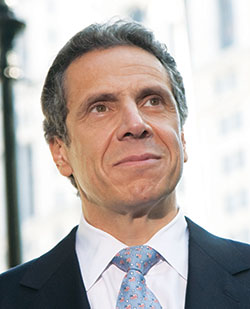Trending
Cuomo’s 421a wage subsidy would be novelty in US
Governor unveiled proposal for affordable housing program last week

Gov. Andrew Cuomo’s proposal to revive the 421a program took the New York real estate industry by surprise last week, but its key provision is just as eye-opening: the addition of a direct wage subsidy would add a new and untested wrinkle to affordable housing policy in the U.S.
“There’s probably never a novel idea but it’s not something that’s done in a lot of cities,” said Rick Jacobus, principal of Urban Planning Consultancy Street Level Advisors. And George McCarthy, president of think tank Lincoln Institute of Land Policy, said he is “not aware” of any such program existing in the U.S.
Cuomo’s proposal, unveiled to developers last week, seeks to revive the 421a tax abatement program, which expired in January. The program offers tax breaks to housing developers who keep a set portion of new units affordable, but labor groups and the Real Estate Board of New York failed to reach an agreement on whether the program should include a prevailing wage requirement.
Cuomo’s new proposal seeks to solve the impasse by adding a minimum wage for construction workers to the program that is partially financed with New York state money. His 421a pitch doesn’t require union labor, nor do developers have to pay prevailing wages.
Below 96th Street in Manhattan, developers would have to pay workers at least $65 an hour, including benefits, for all projects over 300 units seeking 421a. Along the East River in Brooklyn and Queens, developers seeking to receive the tax abatement would have to ensure workers make at least $50 per hour in wages and benefits. But $15, or 30 percent, of those wages would be reimbursed by the state, according to the New York Times. It wasn’t immediately clear how the state would fund the subsidy or how it would be managed.
Similar direct wage subsidies tied to development programs in the U.S are hard to find. Earlier this year, for example, Austin, Texas’ public transit authority Capital Metro agreed to pay a portion of construction wages at the mixed-use Development Plaza Saltillo. But it claimed the wage subsidy would be financed with a rent hike on the public land underneath the project, meaning the private developer would actually foot the bill.
Far more common are indirect wage subsidies, said Jacobus. Several cities tie tax abatements for affordable housing development to prevailing wage requirements. In effect, the tax abatements help pay for union wages, meaning taxpayers indirectly subsidize them.
One urban planner, speaking on condition of anonymity, argued that Cuomo would have done better choosing this more common approach. “Are there any cases in this country where the local labor force is partly unionized and the government subsidizes the non-union labor force?” he said. To him, the proposal is a haphazard attempt to save a program that Cuomo needlessly jeopardized last year by making its future contingent on an agreement between REBNY and the unions. “He broke it and thought someone else would fix it,” the urban planner said.
McCarthy disagreed, arguing that the proposal is a good compromise between the need to keep down the cost of affordable housing development and to ensure that workers make living wages. “I think it’s innovative,” he said. “It does help affordable housing development get on a quasi-level playing field.”




